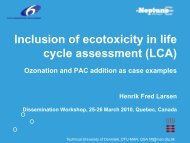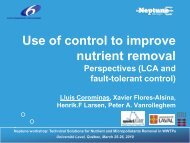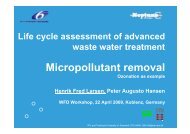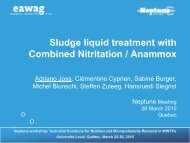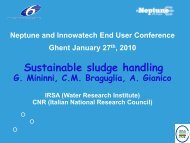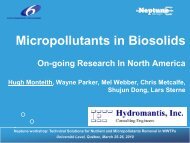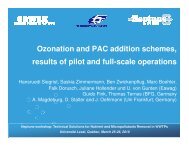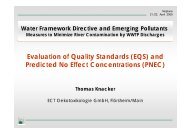D2.1 - EU Project Neptune
D2.1 - EU Project Neptune
D2.1 - EU Project Neptune
You also want an ePaper? Increase the reach of your titles
YUMPU automatically turns print PDFs into web optimized ePapers that Google loves.
NEPTUNE · Contract-No. 036845 Deliverable 2.1<br />
However, the sludge contains harmful heavy metals (Table 4.1b) and the nowadays more<br />
and more observed and investigated micropollutants:<br />
o Polynuclear aromatic hydrocarbons<br />
(PAH)<br />
o Herbicide residues<br />
o Polychlorinated biphenyls (PCB)<br />
o Organo-tin compounds<br />
o Polychlorinated terphenyls<br />
o Phthalate esters<br />
o Phenol<br />
o Petroleum hydrocarbons<br />
o Chlorinated hydrocarbon solvents<br />
and phenols<br />
o Surfactants<br />
o Organochlorine insecticides<br />
o Aromatic amines<br />
o Organophosphorus compounds<br />
Since sludge consists of the material which had to be removed from the water due to<br />
potential risk for the people and the environment, sewage sludge itself has to be treated<br />
before it is finally disposed of in some form. Therefore, while demands on wastewater<br />
treatment are increasing, the techniques for the sewage sludge treatment have to be<br />
improved due to the more strict legislations in this area as well. The cost for sludge treatment<br />
contributes up to 50% to the overall costs of the WWTP (Khiari et al., 2004). Nowadays, at<br />
the most WWTP the mixture of primary and secondary sludge goes to stabilization and<br />
disinfection if used in agriculture (aerobic or anaerobic digestion, composting, pasteurization<br />
etc.) followed by dewatering and drying. The result is stabilized dewatered or dried sewage<br />
sludge that has to be finally disposed of. The major ways for sludge use and disposal are:<br />
application to agricultural land, landfill, sea disposal and incineration. The sea dumping of<br />
sewage sludge was completely abandoned in 1980’. Land filling is also recognized as an<br />
environmental hazard in some countries (banned in Switzerland since 2000 and in Sweden<br />
since 2005). Use in agriculture is in discussion because of the increased amount of organic<br />
micro pollutants and heavy metals in the sludge. Incineration is still thought the best<br />
alternative in terms of volume and hazardous impact reduction as well as energy reuse. The<br />
amount of produced sludge, as well as the methods commonly used for sludge treatment<br />
and disposal, is given in the next table.<br />
22



